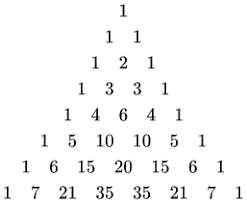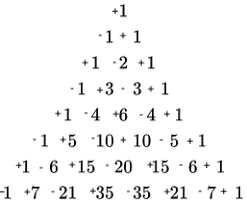Problems
Prove that for all positive integers \(n\) there exists a partition of the set of positive integers \(k\le2^{n+1}\) into sets \(A\) and \(B\) such that \[\sum_{x\in A}x^i=\sum_{x\in B}x^i\] for all integers \(0\le i\le n\).
Diophantine equations are those where we’re only interested in finding the integer (whole number) solutions. Some of these equations are quite simple, while others look simple but are actually very difficult. The most famous one is Fermat’s Last Theorem, which says that when \(n>2\), there are no solutions to \[x^n+y^n=z^n.\] Pierre de Fermat claimed that he proved this in 1637, scribbling it in the margin of a book, but said “I have discovered a truly marvelous proof of this, which this margin is too narrow to contain." It was only proved by Andrew Wiles in 1995. Today’s problems won’t take 358 years to solve.
Pascal’s triangle, (known as Khayyam’s triangle in Iran and Yang Hui’s triangle in China) is seen below.

Well, what does it mean? We start with diagonal lines of 1s. Then every other number in the interior is the sum of the two numbers above it. With this simple rule, the triangle shows lots of cool structure.
In Pascal’s triangle, what are the numbers in the diagonal next to the diagonal of ones?
In Pascal’s triangle, what is the sum of the entries in each row?
Oliver throws a fair coin three times. What are his chances of getting three heads, two heads and one tail, one head and two tails, or three tails?
In Pascal’s triangle, what numbers appear in the diagonal next to the positive integers?
Five friends get together and want to take a photo. They all agree that two of them should take a photo of the other three. How many ways can you choose the three people to be in the picture?
In Pascal’s triangle, what’s the sum of the numbers in each row when you put a minus sign in front of every other number?

What is \(11^2\), \(11^3\) and \(11^4\), and what do these numbers have to do with Pascal’s triangle? What goes wrong with \(11^5\)?